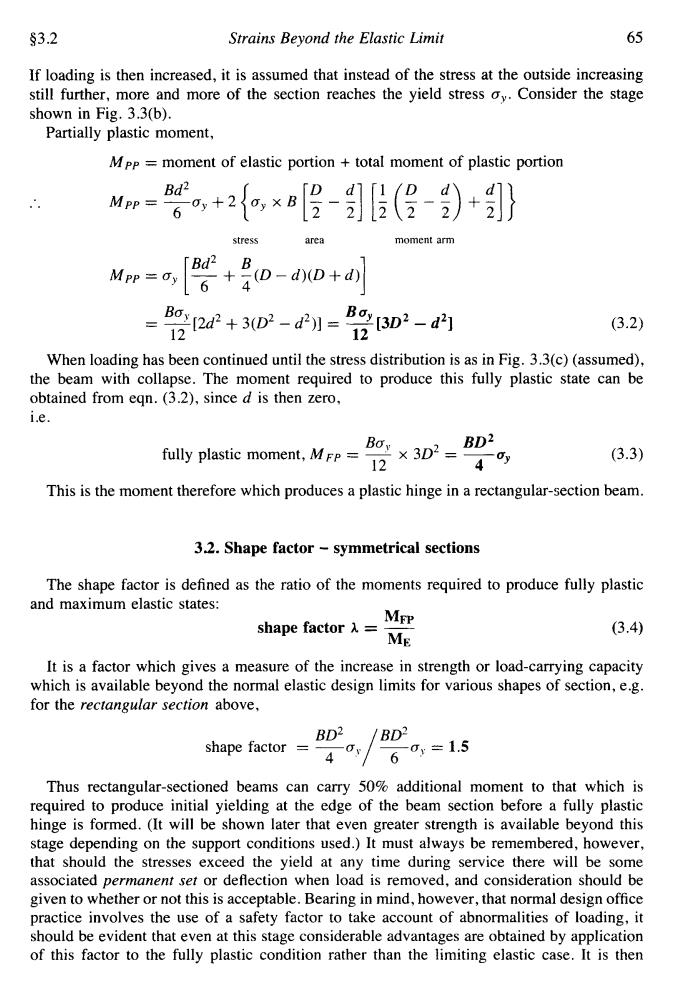正在加载图片...

$3.2 Strains Beyond the Elastic Limit 65 If loading is then increased,it is assumed that instead of the stress at the outside increasing still further,more and more of the section reaches the yield stress oy.Consider the stage shown in Fig.3.3(b). Partially plastic moment, MPp moment of elastic portion total moment of plastic portion M=g,+2{o,x[B-引(?-)+ Bd2 stress area moment arm Bd2 B Mpp=+(D-d)(D+d) 2d+3D2-4P1=D2-的 212 (3.2) When loading has been continued until the stress distribution is as in Fig.3.3(c)(assumed), the beam with collapse.The moment required to produce this fully plastic state can be obtained from eqn.(3.2),since d is then zero, i.e. fully plastic moment,MP=12 Ba.x 3DBD 49 (3.3) This is the moment therefore which produces a plastic hinge in a rectangular-section beam. 3.2.Shape factor -symmetrical sections The shape factor is defined as the ratio of the moments required to produce fully plastic and maximum elastic states: MFP shape factor=ME (3.4) It is a factor which gives a measure of the increase in strength or load-carrying capacity which is available beyond the normal elastic design limits for various shapes of section,e.g. for the rectangular section above, B /BD2 shape factor = 4r/60,=1.5 Thus rectangular-sectioned beams can carry 50%additional moment to that which is required to produce initial yielding at the edge of the beam section before a fully plastic hinge is formed.(It will be shown later that even greater strength is available beyond this stage depending on the support conditions used.)It must always be remembered,however, that should the stresses exceed the yield at any time during service there will be some associated permanent set or deflection when load is removed,and consideration should be given to whether or not this is acceptable.Bearing in mind,however,that normal design office practice involves the use of a safety factor to take account of abnormalities of loading,it should be evident that even at this stage considerable advantages are obtained by application of this factor to the fully plastic condition rather than the limiting elastic case.It is then$3.2 Strains Beyond the Elastic Limit 65 If loading is then increased, it is assumed that instead of the stress at the outside increasing still further, more and more of the section reaches the yield stress o,,,. Consider the stage shown in Fig. 3.3(b). Partially plastic moment, Mpp = moment of elastic portion + total moment of plastic portion stress area moment arm 1 B Mpp = cy [T + x(D - d)(D +d) = BO, -[2d2 + 3(D2 - d2)] = B -[3D2 or - d2] 12 12 (3.2) When loading has been continued until the stress distribution is as in Fig. 3.3(c) (assumed), the beam with collapse. The moment required to produce this fully plastic state can be obtained from eqn. (3.2), since d is then zero, i.e. BU,, BD~ fully plastic moment, MFP = - x 3D2 = - 12 4 uy (3.3) This is the moment therefore which produces a plastic hinge in a rectangular-section beam. 3.2. Shape factor - symmetrical sections The shape factor is defined as the ratio of the moments required to produce fully plastic (3.4) and maximum elastic states: MFP shape factor A = ~ ME It is a factor which gives a measure of the increase in strength or load-carrying capacity which is available beyond the normal elastic design limits for various shapes of section, e.g. for the rectangular section above, BD~ 4 shape factor = -cy/? cy = 1.5 Thus rectangular-sectioned beams can carry 50% additional moment to that which is required to produce initial yielding at the edge of the beam section before a fully plastic hinge is formed. (It will be shown later that even greater strength is available beyond this stage depending on the support conditions used.) It must always be remembered, however, that should the stresses exceed the yield at any time during service there will be some associated permanent set or deflection when load is removed, and consideration should be given to whether or not this is acceptable. Bearing in mind, however, that normal design office practice involves the use of a safety factor to take account of abnormalities of loading, it should be evident that even at this stage considerable advantages are obtained by application of this factor to the fully plastic condition rather than the limiting elastic case. It is then